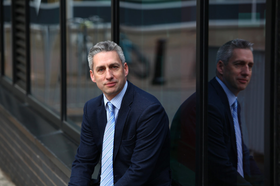event services in Edinburgh
Professor Sean Smith, Edinburgh Napier University

We are delighted to introduce Professor Sean Smith, Director of the Institute for Sustainable Construction (ISC) and Professor of Construction Innovation. As part of VisitScotland’s Legends campaign, Sean provides an excellent insight into Edinburgh’s innovative engineering sector.
The Institute for Sustainable Construction (ISC) is based within the School of Engineering and the Built Environment, please tell us what the main strengths and expertise of the Institute are?
The Institute for Sustainable Construction at Edinburgh Napier has a wide range of strengths and expertise in diverse engineering areas that makes it unique.
It has both a national and international reputation in offsite construction, which is really helping the global trend for this type of construction. Our links with the likes of Scandinavia, North America and other countries is helping to facilitate this growth and reach for expertise. Our work in offsite construction is led by Professor Robert Hairstans.
Separately, we have specific expertise in timber, timber construction systems and timber engineering. Led by Associate Professor Dan Ridley-Ellis, we are internationally recognised in this area, with many of our staff currently advising the ISO and CEN committees for timber standardisation and grading.
We’ve also had significant input to improving the quality of life for people through acoustic engineering and sound insulation. The Institute is also heavily involved with the development of new products for reducing noise and sound transmission. Since 2004 over 1 million new homes in the UK have adopted our acoustic engineering and sound insulation technical specifications, leading to some of the highest sound insulation levels for new housing in the world.
We’re exceptionally fortunate to have the Scottish Energy Centre (SEC) as part of our Institute. SEC has been a real driver in looking at energy and building performance. It is currently involved in some exciting work on advanced solar thermal heaters for heating water and is using the University’s Merchiston campus roof for these prototypes. This is being led by Professor John Currie.
We also have another strand to the Institute, which is more focused on policy and the circular economy. This is called Smart Cities and is led by Professor Mark Deakin. The concept of Smart Cities offers a revolutionary vision of urban design for sustainability. Alongside incorporating new technologies, Smart Cities also incorporate consideration of social and environmental capital in order to transform the life and work of cities.
The ISC’s research is world leading, what innovative projects are you working on at the moment?
Our fundamental research looks at a plethora of areas - whether it is going back to look at advanced energy insulation systems, new product engineering innovations or developing future building regulations.
In our energy research we really try to debunk some of the myths which are out there, as we look to play a part in reducing and eradicating fuel poverty.
In terms of our offsite research, there’s a huge amount of work happening around skills development. We want our future engineers to have the skills to use the systems, products and processes of tomorrow.
We also have two or three major projects ongoing. These are called Project X’s and they range from looking at the design of infrastructure to protect buildings from storm surge and tsunami to the design of future refugee housing. Research that makes a positive impact to society is a key theme throughout the Institute’s work.
How has your career led you to where you are today?
My first degree was in construction economics. I really enjoyed the architectural technology side of that degree. I had an interest in acoustics which I think stemmed from my time at St Mary’s Music School in Edinburgh when I was young.
After I realised that quantity surveying perhaps wasn’t for me, I decided to study for a PhD in building acoustics – linking the building’s acoustics with architectural technology. I then worked for three years with the Defence Evaluation and Research Agency (DERA), which is part of the UK Ministry of Defence (MoD).
I spent some time in Canada at the Canadian Government construction research laboratories and was then a guest research fellow working with University of Ferrara engineering department in Italy, and finally a guest scientist for the German Government in Braunschweig at the PTB; it was really quite humbling to be a guest scientist there, I was the youngest guest scientist they’ve ever had in fact – no pressure!
I then joined Edinburgh Napier in 2000/2001, initially linking up with RMP Acoustics. I then led the Building Performance Centre research undertaking multi-discipline engineering projects involving acoustics, energy and structures. I became a Professor in Construction Innovation in 2008 and then Director of the Institute in 2010.
The Institute is humbled and honoured to have won the Queen’s Anniversary Prize twice for the positive impact of our research on industry, society and environment. It is a great accolade for all the staff. There is no other School in the country that has won twice for two different areas. I think that is unique.
Please tell us about your day-to-day role?
In any week, it is so diverse – and I love my job for that.
Alongside my work for the Institute, I teach Research and Innovation to our second year architectural technology students which is great – they seem to really enjoy it. I love the teaching aspect of my job. We bring in some of our previous projects that we’ve just completed within the industry – without giving any commercial sensitivities away – to show the impact journey that the research and innovation has undertaken. The students really love practical examples and enjoy hearing from our industry and government guest speakers. This also allows us to discuss challenges and opportunities through research and innovation, the good and the bad as well – and they like that honesty.
In any one week, I’m probably in at least two or three meetings with local authorities or government and at least twice a week I’m in discussions with industry on various projects. One of the things I really enjoy is the inter-disciplinary nature of our work. Something comes up and we’re like ‘Oh, you need to speak to such and such’ – and it’s not just in the school either. We’re trying to introduce people who are helping elsewhere.
I think that multi-disciplinary aspect of being on this campus – with so many different skills and expertise available - is quite special.
What do you think are the city’s main engineering strengths and what are the benefits of working within this sector?
The engineering and architecture of some of the buildings within the region is a major strength of the city. The phenomenal scale of the award-winning Quarter Mile development is fantastic. We’ve been involved with the Dynamic Earth building. It’s the engineering and architecture behind iconic buildings that make people remember them.
I also think that from an engineering point of view there are some very well-known consultancies in the city. These engineering companies have helped create a strong base for the University to work with.
In terms of quality of life, Edinburgh is fantastic. It is the fastest-growing region of Scotland. It is the fifth fastest-growing region in the UK. The City Region Deal – which has been earmarked for £1.3billion of investment – means there will be new and exciting infrastructure, buildings and research facilities brought to fruition. Edinburgh is a knowledge city that’s really going to grow.
In terms of the city and region, the forecasted population growth is that we need to build 40% more homes over the next 20 years than we did in the 20 years prior to the recession. This is going to require excellent engineering skills which we can help supply.
Some of the planned infrastructure projects are also quite exciting, such as the Sheriffhall roundabout project which will benefit from more than £100million investment. There’s a lot coming down the line. It’s an exciting time for the city.
What are the main challenges of working in the engineering sector?
Like all industries, there are challenges. There are constant changes to building regulations. There are changes in terms of energy performance and how we’re going to use energy in buildings and we’ve obviously always got to be aware of these.
Globally, there are challenges regarding material sourcing. We’re going to have to get much better at how we are re-using and recycling from infrastructure projects. There is some good work going on in this area but we really need to up the game.
The upside of many future low carbon policies is that we’ll see a bigger use of timber and timber engineering. We’ll utilise more home grown timber and that sector is already worth more than £1billion to Scotland’s economy. I serve on the industry leadership group for the timber and forestry sector and they want to aim for a £2billion sector in the next six to seven years. So whilst there are challenges, there are also ambitions.
Edinburgh and the south-east has a huge number of our graduates in engineering and architectural technology – many of whom have studied at Edinburgh Napier and are now working in practices which is great.
We’re creating a legacy to help tomorrow’s communities. We’re delighted to be doing just that.

